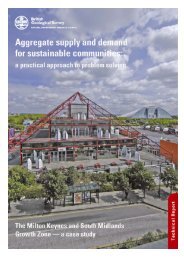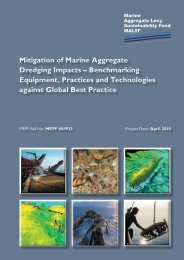creating environmental improvements through biodiversity
creating environmental improvements through biodiversity
creating environmental improvements through biodiversity
Create successful ePaper yourself
Turn your PDF publications into a flip-book with our unique Google optimized e-Paper software.
3.5 WORKING TOGETHER<br />
The importance of stakeholders<br />
The value of stakeholder engagement is a common feature of many of the reviewed projects. Bringing<br />
all stakeholders together for discussion at an early stage is essential for successful minerals planning for<br />
<strong>biodiversity</strong>, both at a strategic (landscape) level and on individual sites. Considerable benefits can be gained<br />
from this, as seen in many of the successful ALSF projects. It ensures that outputs are as useful as possible for<br />
all involved. In many cases, ALSF work has brought all types of stakeholders together for the first time.<br />
Providing numerous datasets together in one platform, such as in Steadman et al. (2005), has the potential to<br />
act as a focus for stakeholder discussion about the location of sites in strategic planning. Parker et al (2004)<br />
engaged face to face with key stakeholders, and as a result noticed increased enthusiasm and conservation<br />
knowledge among local minerals operators, and awareness among local farmers and landowners.<br />
Successful integration of multiple end-uses<br />
Bringing together multiple end-uses on a site can, if managed and planned well, provide funding for long-term<br />
management. Harris (2004) showed how a visitor centre and associated businesses could provide sufficient<br />
funds to make a site in the Idle Valley self-sufficient after initial investment in set-up.<br />
Sustainable Aggregates Creating Environmental Improvements <strong>through</strong> Biodiversity<br />
Mineral sites restored for <strong>biodiversity</strong> [to open water – not clear if also true for reedbed, wet grassland],<br />
can have a flood alleviation benefit by providing flood storage (Clayton et al. 2004) Mineral sites restored for<br />
<strong>biodiversity</strong> and flood alleviation, and thereby meeting two important objectives on one site, are the focus of<br />
the SAND project in continental Europe.<br />
Part of successfully integrating end-use demands is providing contacts for areas of expertise such as<br />
geological conservation, archaeology, agricultural soils management etc. This was done in the West Sussex<br />
County Council handbook (Ryland et al., 2005), and should be extended to other areas.<br />
A number of combinations of end-uses are possible, if planned and integrated well so that habitat creation is<br />
not marginalised:<br />
• Cripps et al. (2004) points out the potential for educational or recreational facilities based on ecological,<br />
geological, archaeological and industrial resources, and that surveys are needed to inform this.<br />
• Portland Sculpture and Quarry Trust (2004) used extensive community and stakeholder engagement in<br />
designing a restoration plan for Independent Quarry that integrated art, heritage, landscape, environment<br />
and education. It focused on local species, low-nutrient substrates, natural regeneration and provision of<br />
micro habitats, with key invertebrates a main focus. It also placed emphasis on benefits for mental health and<br />
disadvantaged groups. However large scale habitat creation did not appear to be incorporated at the site.<br />
• Roberts and Buffin (2005) states that restoring sites for their invertebrate interest can provide<br />
communities with access to an important recreation and education resource. This Buglife project should<br />
work with industry to change public perceptions on this<br />
• Roberts and Buffin (2005) states that managing sites for geodiversity can benefit invertebrate population,<br />
25

















